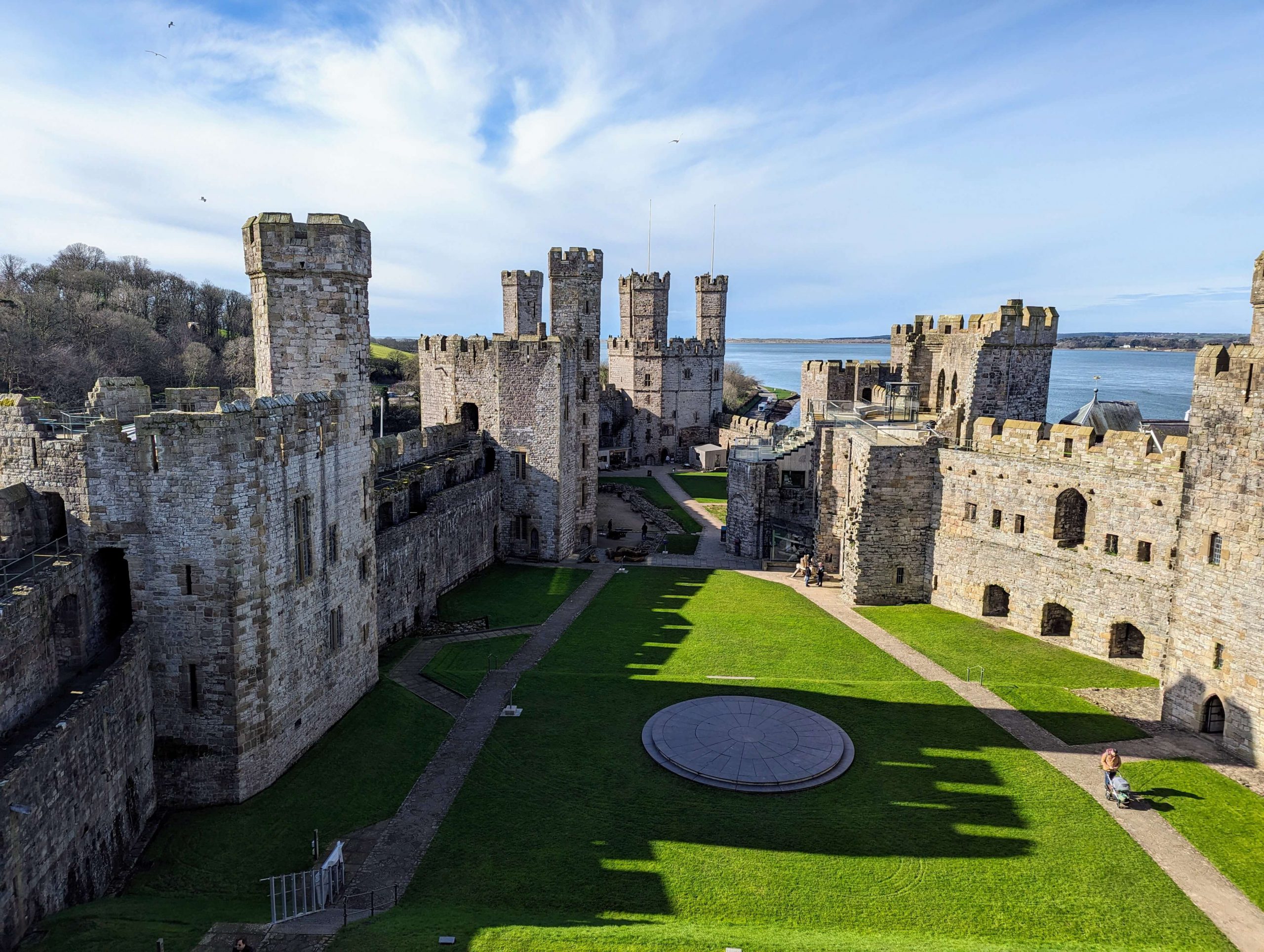The impressive Caernarfon castle stands quite magnificently on the eastern shore of the Menai Strait and in the town of Caernarfon. This Edwardian masterpiece formed part of the ‘Ring of Iron’ – a series of stone castles that circled northern Wales, built after Edward I’s conquest of Wales.
| Built | 13th Century |
| Type | Medieval Fortress (Edward I’s Ring of Iron) |
| Condition | Ruinous (major stonework intact) |
| Ownership | Cadw |
| Access | Public – Admission Charge |
| Postcode | LL5 2AY |
Click here to watch our video exploring Caernarfon Castle and discover its history
Roman Origins
The first evidence of fortifications at Caernarfon comes from the Romans who built the strategically placed fort of Segontium just on the eastern outskirts of the modern town. Founded in AD77 by the Roman general Agricola (who was responsible for a lot of the Roman conquest of Britain), Segontium likely takes its name from an ancient derivative of the river Seiont.
Overlooking the Menai Strait, the fort acted as the administration centre for Anglesey, and evidence through the discovery of coins suggests that the Romans occupied Segontium until around AD394.
The Romans left Britain less than 20 years later and not a lot is really known about the status of Caernarfon for the next 650 years, not until the arrival of the Normans.
Norman Presence
William the Conqueror set his sights on establishing Norman rule over areas of Wales quite soon after the Norman Conquest of England in 1066, and it is mentioned in the Domesday Survey of 1086 that Norman Robert of Rhuddlan was effectively in charge of northern Wales. Robert had previously built Twthill castle (near Rhuddlan) in 1073 which acted as a base where the Normans could launch advances into north Wales.

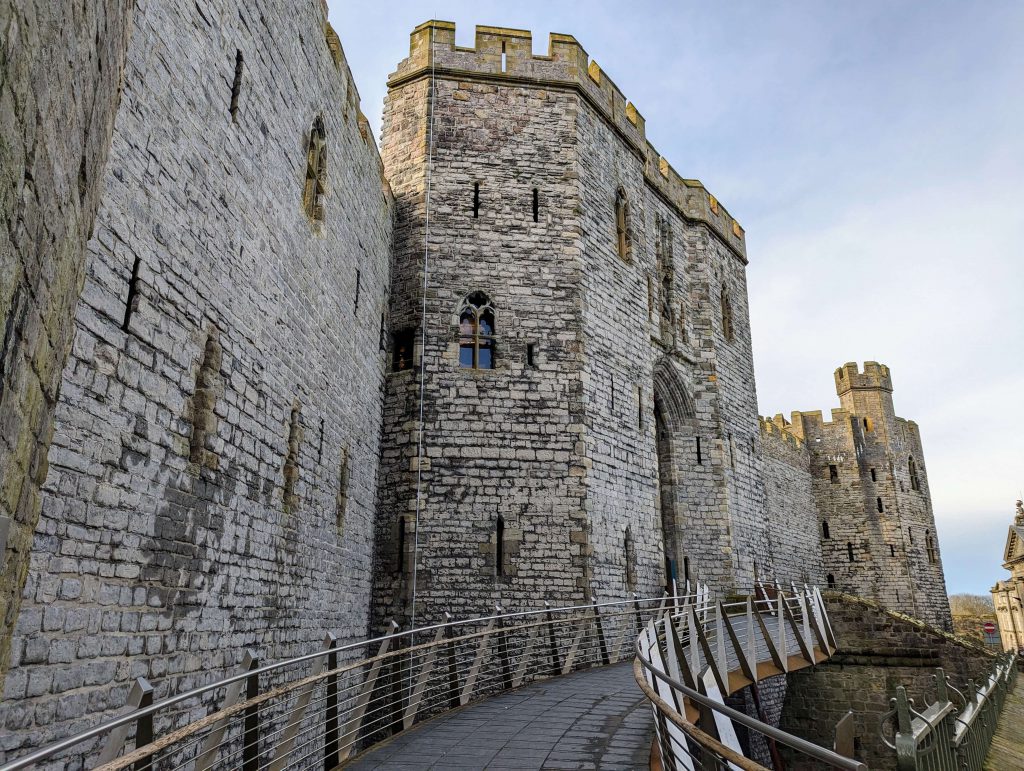
Robert was killed by the Welsh towards the end of the 11th century so his cousin, Hugh d’Avranches first Earl of Chester, was left to bolster Norman control in this area of Wales and went on to construct three castles. One was located at Aberlleiniog in Anglesey, one was located somewhere in the region of Meirionnydd (location is unknown) and another at Caernarfon.
Hugh’s castle at Caernarfon, which was established in around 1093, was placed right on the peninsula that was formed by the Menai Strait, the estuary of the River Seiont and the Cadnant brook. The castle’s design was that of a motte and bailey construction, with a timber palisade and large circular mound which would have likely had a wooden keep built on the top of it. The location of the bailey is not clear, but the mound was incorporated into the eastern ward of the stone Edwardian castle that followed.
The Welsh were able to take possession of Caernarfon castle when they recaptured the Kingdom of Gwynedd in 1115. They held the castle until 1283, up until the point where the Welsh were defeated by Edward I. Through documents of the time, it is known that during the Welsh ownership of the castle, Llywelyn the Great and Llywelyn ap Gruffudd (Llywelyn the Last) both occasionally resided at Caernarfon respectively.
Edward I’s Conquest of Wales
On the 22nd March 1282, war broke out between the English ruled by Edward I, and the Welsh led by Llywelyn ap Gruffudd. Llywelyn was killed in December of that year and his brother Dafydd ap Gruffydd continued the fight, but Edward was making significant progress, capturing castles as he marched through northern Wales. One of those was Dolwyddelan castle, a fortification that guarded a key road that opened up access to other areas of the north Welsh landscape.
Edward went on to capture Dolbadarn Castle in May 1283, the last castle held by Dafydd. This marked victory for the English and the end of the war. But Edward knew that in order to maintain his victory and rule over the Welsh, he needed something that could quickly squash any kind of rebellion or uprising. He layed out a plan of building what is termed as the ‘Ring of Iron’, a series of castles that would surround north Wales. Each castle would have a garrison that could be called upon to march out and crush any sign of rebellion.
He started the construction of a castle at Conwy which was then soon followed by two more castles at Harlech and Caernarfon. All three of them were built quickly, simultaneously and at a scale that dwarfed the recent castles built at Rhuddlan and Flint, and all three of them were designed and overseen by the master of military architecture James of Saint George of eastern France.
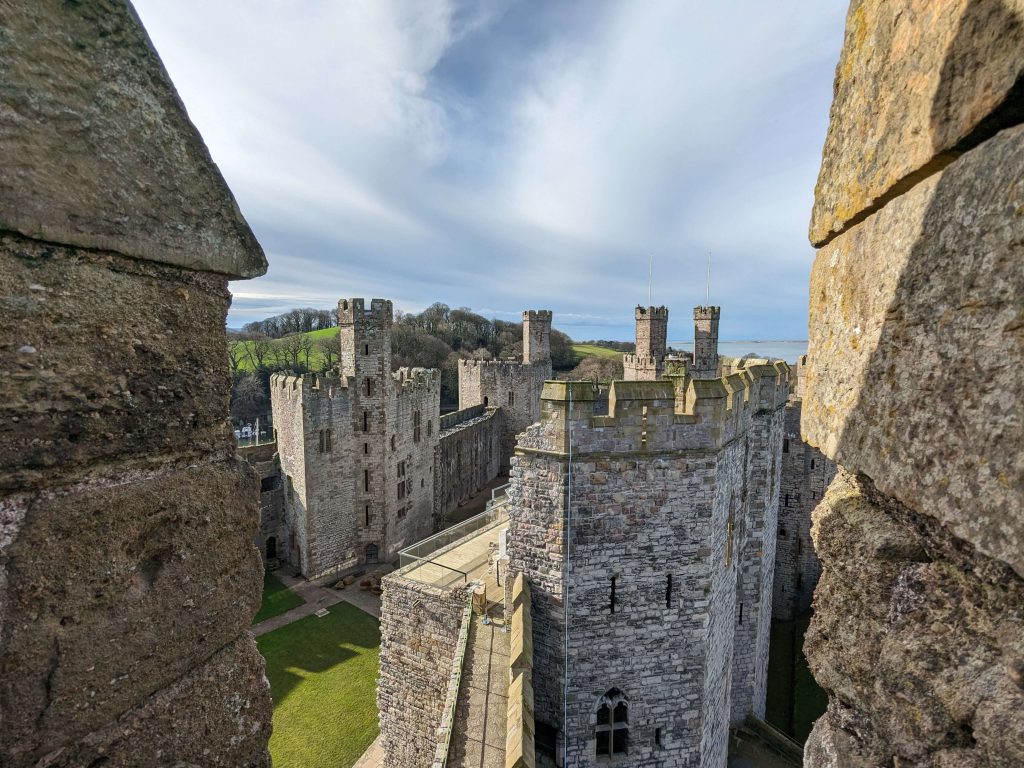

Phase I
The first recorded construction entry for Caernarfon was on 24 June 1283 which details work being done on a new ditch that would separate the castle from the streets and buildings of the town to the north. This was followed up by the construction of a barricade which would surround and protect the construction site while the permanent defences were being built.
Timber for the castle came from as far as Liverpool, and stone was quarried from the local area. Hundreds of workers would have been brought in to dig out the moat and foundations, and as the construction site got bigger and encroached into the town, houses that stood in the way were demolished with residents of them not receiving any sort of compensation until three years later.
Edward and his queen, Eleanor of Castile, arrived from Conwy to stay at the castle in mid July 1283. Construction of the castle had only really been going on for a month so the castle was nowhere near close to being able to accommodate anyone. They needed somewhere to stay so accommodation in the form of temporary timber apartments were built, and they stayed for over a month.
Construction continued into 1284 and while the general progress of the castle’s construction is unknown, the south wall and towers would likely have been built to the height of the first floor. Caernarfon became the new administrative centre of Gwynedd after the Statute of Rhuddlan was enacted, which essentially introduced English Common Law to Wales.
The title Prince of Wales had historically been a symbol of power as well as a protectorate to the Welsh people. Edward knew this and after his conquest of Wales he wanted another son. On 25 April 1284, while staying at Caernarfon for a 2nd time, Eleanor gave birth to their son, Edward II. Legend has it that in order to win over the Welsh, Edward I had promised them that the next Prince of Wales would be Welsh and he presented them with his Welsh born son. Most of Edwards previous children had passed away by this point, and four months after Edward II birth, Alphonso the oldest son and heir to the English throne also passed away, leaving Henry as heir. Henry II was formally given the title Prince of Wales in 1301.
By this point the castle was starting to take shape and by 1285 the town walls, which were being built at the same time, were complete. After a couple more years of high expenditure on the castle, spending and building work began to drop off from 1288 to the point of accounts ceasing altogether in 1292.
Approximately £12,000 had been spent on Caernarfon by 1292 and the result was the completed town walls, and the external south facing façade and eastern portion of castle had been built to a sizeable height (essentially from the Eagle Tower to the North-East Tower). This completed the defensive enclosure around the town.
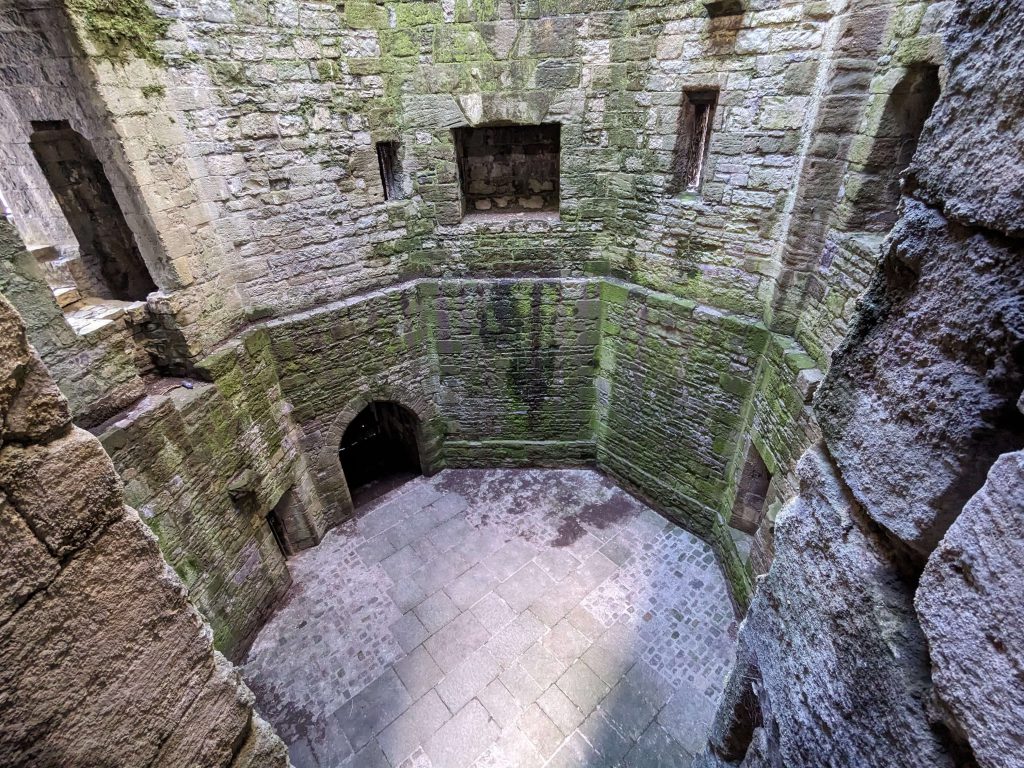

Phase 2
In 1294 a Welsh rebellion broke out led by Madog ap Llywelyn, a relative to the last recognised native Welsh prince (Llywelyn ap Gruffudd). The English rulers had imposed new taxes which enraged the Welsh, and after months of planning a number of castles were attacked throughout Wales. Caernarfon, being a symbol of English power, was a target which Madog and his forces overran and captured. The town walls were badly damaged, anything in the town that could be burnt was set on fire, and the castle, being incomplete, was easily captured.
Edward ordered an immediate counter-attack in the winter of 1294 and by the summer of 1295 the English took back Caernarfon and started to refortify the town. The town walls were rebuilt as a priority at the cost of £1,195, or half the cost of the original construction. Focus then shifted to the incomplete castle which had seen no work done for three years.
Documents indicate that first focus was the northern façade, as it had been clearly shown during the rebellion that without this the castle’s defences were compromised. By 1301 £4,500 had been spent on the north wall and towers, which linked the Eagle Tower and North-East tower along the northern face.
After 1301 construction was put on hold again, likely due to the need to divert funds and labourers north to support the war between England and Scotland which included Walter of Hereford, Caernarfon’s master mason who had been overseeing the construction since 1295. Walter returned in 1304 and once again construction resumed and was able to continue at a steady rate up until 1330. The Eagle Tower was finally completed during this phase with its fourth storey.
Payments ceased to be recorded by 1330 and the state of the castle at this point is pretty much what stands today. Despite the vast sums of money spent (£20,000 – £25,000 by this point from 1283), the castle was left unfinished. The backs of the King’s Gate and Queen’s Gate were never completed and foundations inside the castle suggest other buildings were planned.
Features
Even unfinished Caernarfon is truly a formidable fortification. The Eagle Tower, the largest of the towers, is four stories high (with one story being a basement) and was probably intended for accommodation on a grand scale. On top of the tower sits three turrets which were decorated with eagles, and gave the tower a distinctive and unique appearance.
Within the castle is an abundance of passages that allowed the garrison (which could be as less as 20 men) to quickly move between the towers. The castle contained few large windows but instead had many arrow slits which would have made it very difficult for attackers. The walls were up to 20 feet thick in places.
The King’s Gate is the main entrance to the castle and demonstrates the design of an immensely strong and menacing defence. If completed an L-shaped entrance passage would have contained a series of five gates. Above are murder holes where hot sand would have been poured onto attackers, and then numerous arrow slits to the sides.


Later History
The political arrangements established by Edward I after the conquest of Wales remained in place for the next 200 years, and Caernarfon continued to be garrisoned throughout this period. Relations between the Welsh and their English conquerors began to strain, with the Welsh becoming frustrated as many of the important administrative jobs in Wales were being given to the English.
At the start of the 15th century tensions erupted into a Welsh revolt led by Owain Glyndŵr, known as the Glyndŵr Rebellion. Caernarfon was one of Glyndŵr’s targets and was first besieged during the revolt by the Welsh in 1401 at the Battle of Twt Hill. The English successfully fended off this first attack.
In 1403 Glyndŵr and his Welsh forces attacked the castle for a second time, but this time with the aid of French allies. The attackers brought a number of different types of siege engine with them, but with the walls being so tall and thick, they had no effect. The only type of siege engine that could have turned the tide would have been a large trebuchet which the attackers didn’t have. It is recorded that the garrison was defended by just 28 men and once again successfully defended the castle. With two failed attacks thwarted by a small garrison, we really get a glimpse of how near-impossible it was to break Caernarfon castle.
Up to this point Caernarfon was always considered an important administrative centre and was in effect the capital of north Wales, however this would all soon change.
The Tudors
When the Tudor family became the ruling House of England and Wales in 1485, change in the way Wales was governed was established. Through this the Tudor family, which originated from Wales, were able to ease the hostilities between the Welsh and English and stabilise the political scene. With this, the need for impressive fortifications soon diminished and Caernarfon castle, along with others, became neglected, and by 1538 were recorded as ruinous.
At Caernarfon, parts of the castle that would naturally require maintenance deteriorated. Timbers became rotten and many of the roofs fell in, with just the Eagle Tower and King’s Gate’s roofs still in place by 1620. The contents of the castle’s buildings were gutted, leaving nothing of value, but the castle (and town) walls remained in extremely good condition so its primary purpose of being a formidable fortification remained intact.
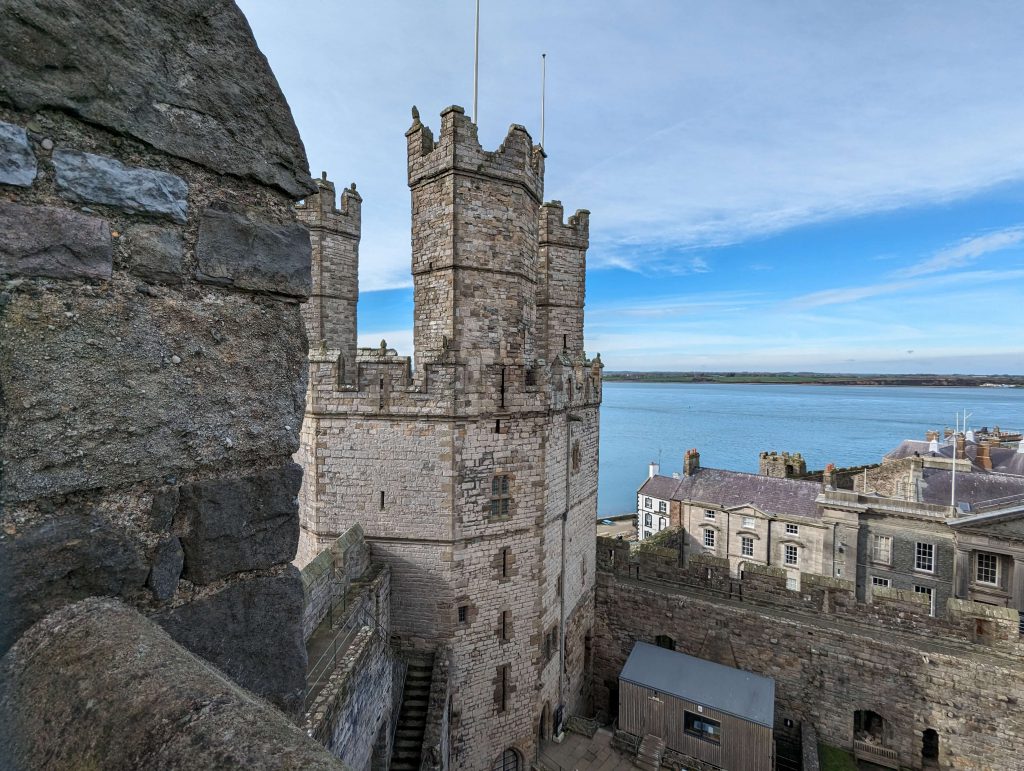
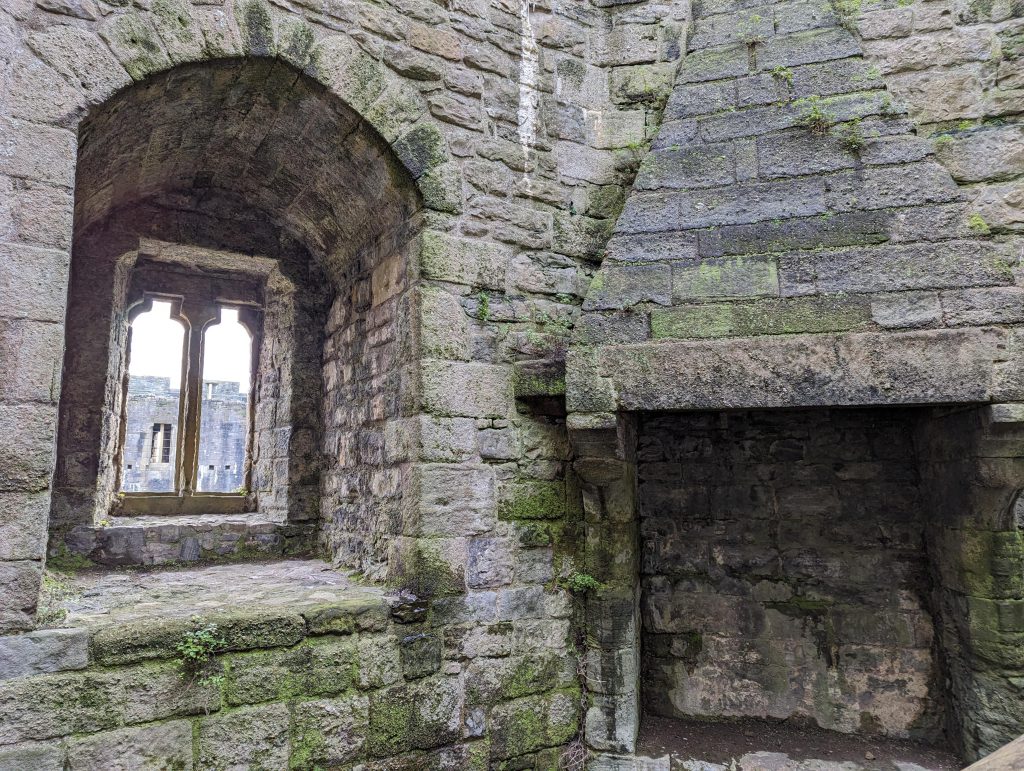
English Civil War
During the English Civil War of 1642 – 48 the castle was occupied by a Royalist garrison. Through the course of the war the castle was besieged three times and eventually the constable, John Byron (1st Baron Byron) surrendered the castle to Parliamentarian forces in 1646.
This would be the last time Caernarfon would see any action and soon after in 1660 an order form the Parliamentarians was made to dismantle the walls to stop the castle from being used again for military purposes. This fate, known as slighting, sadly befell many castles across Wales and England at the time. Miraculously though Caernarfon castle managed to escape this doom, as very little was taken down, if the work was ever started.
Whilst the castle was able to avoid any demolition, it wasn’t able to avoid any further neglect, which continued into the late 19th century. Eventually the government began to fund repairs to Caernarfon castle from the 1870s under the direction of deputy-constable Llewellyn Turner. Roofs, steps and battlements were restored and repairs were made to the Chamberlain Tower. Much of what we see today owes much to the determination of Turner.
In 1911 the Investiture of Edward Prince of Wales was held at Caernarfon, which was the first to take place in Wales for centuries. The ceremony was held again there in 1969 for Charles, Prince of Wales (now Kings Charles III).
Since its construction the castle was always the property of the Crown and had later been managed by the Office of Works which was established in 1378 to oversee the maintenance of the royal castles and residences.
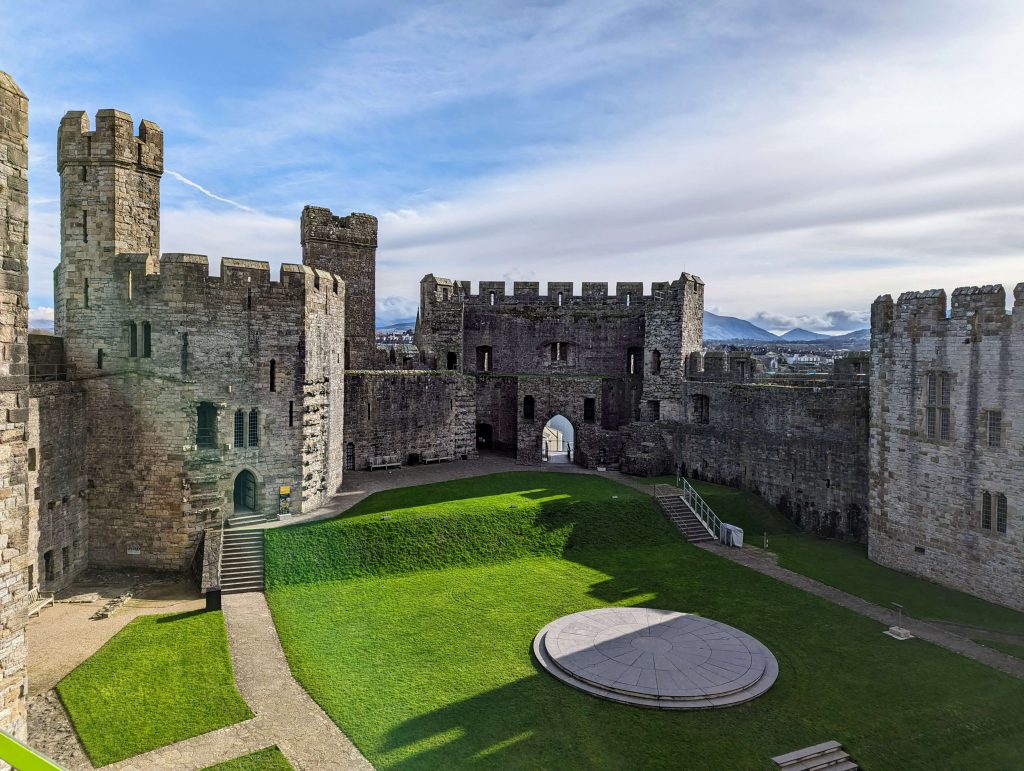

Today
The castle and town walls of Caernarfon, along with Beaumaris and Harlech castles and the castle and town walls of Conwy, form the UNESCO designated ‘Castles and Town Walls of King Edward in Gwynedd’ World Heritage Site, being ‘the finest examples of late 13th century and early 14th century military architecture in Europe’.
Caernarfon Castle is open to the public and is managed by Cadw, the Welsh Government’s historic environment service. In 2023 a massive £5 million conservation project was completed which opened up parts of the castle that had previously been inaccessible.
Ghost Stories
Floating Lady
For centuries there have been sightings reported of a ghost called the Floating Lady. We don’t know who this mysterious person is, or what her connection to the castle might be, but regularly people have seen her floating through the castle and down corridors.
It has also been reported that electrical equipment has been affected with items being tampered with and light flickering on and off.
Queen Eleanor
Legend has it that Queen Eleanor’s ghost occasionally manifests within Caernarfon. As the wife of King Edward I, she wielded significant influence in mediaeval England. Witnesses claim to have seen her ghost pacing the castle battlements and strolling through the courtyard. One tale suggests her spirit is unable to find peace, possibly due to lingering worries about a ransom paid for the town. Alternatively, some attribute eerie sounds of weeping near the castle’s King’s Gate to her presence. The haunting presence of Queen Eleanor only enhances the allure of this grand castle.
Click below to explore Caernarfon Castle with us

